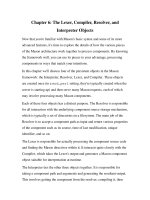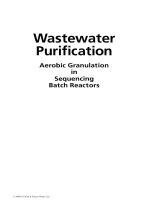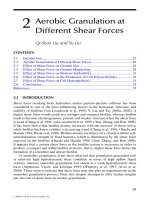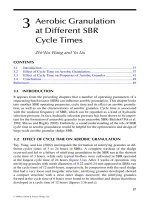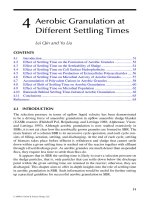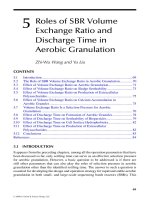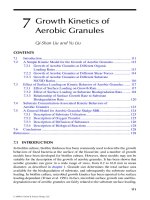Wastewater Purification: Aerobic Granulation in Sequencing Batch Reactors - Chapter 6 pptx
Bạn đang xem bản rút gọn của tài liệu. Xem và tải ngay bản đầy đủ của tài liệu tại đây (666.43 KB, 26 trang )
85
6
Selection Pressure Theory
for Aerobic Granulation
in Sequencing
Batch Reactors
Yu Liu and Zhi-Wu Wang
CONTENTS
6.1 Introduction 85
6.2 Is Aerobic Granulation Inducible? 86
6.3 Earlier Understanding of Aerobic Granulation 86
6.4 Brief Review of Parameters Contributing to Aerobic Granulation 87
6.4.1 Substrate Composition and Loading 88
6.4.2 Hydrodynamic Shear Force 88
6.4.3 Feast-Famine Regimen 89
6.4.4 Feeding Strategy 89
6.4.5 Dissolved Oxygen 89
6.4.6 Reactor Conguration 90
6.4.7 Solids Retention Time 90
6.4.8 Cycle Time 90
6.4.9 Settling Time 91
6.4.10 Exchange Ratio 92
6.4.11 Discharge Time 92
6.5 Main Selection Pressures of Aerobic Granulation 92
6.6 A Selection Pressure Theory for Aerobic Granulation in SBRs 93
6.7 Failure of Aerobic Granulation in Continuous Microbial Culture 97
6.8 Upscaling Aerobic Granular Sludge SBRs 100
6.9 Prediction of Settling Velocity of Bioparticles 102
6.10 Conclusion 107
References 107
6.1 INTRODUCTION
It appears from the preceding chapters that almost all research on aerobic granula-
tionhasbeenconductedinsequencingbatchreactors(SBRs),whilenosuccessful
aerobic granulation has been observed in continuous microbial culture. As shown in
chapter5,itisbelievedthataerobicgranulesformthroughself-immobilizationof
53671_C006.indd 85 10/29/07 7:16:14 AM
© 2008 by Taylor & Francis Group, LLC
© 2008 by Taylor & Francis Group, LLC
86 Wastewater Purification
bacteria when suitable selection pressure is provided in the SBR. Compared to con-
tinuousmicrobialculture,theuniquefeatureofanSBRisitsabilitytobeoperated
inacyclicmode,andacycleofSBRforaerobicgranulationmaycompriselling,
aeration, settling, and sludge discharge.
Anumberofparametershavebeenknowntoinuencethepropertiesofaerobic
granules formed in SBRs. Basically, contributing parameters include substrate com
-
position,organicloading,hydrodynamicshearforce,feast-famineregimen,feeding
strategy, dissolved oxygen, reactor conguration, solids retention time, cycle time,
settling time, and volume exchange ratio, while only the parameters associated with
selectionpressureonsludgeparticlescancontributetotheformationofaerobicgran
-
ules, as shown in chapters 4 and 5. In an SBR, three major selection pressures have
been identied, and they are settling time, volume exchange ratio, and discharge time
(see chapters 4 and 5). In fact, selection pressure in terms of upow velocity has been
shown to serve as an effective driving force towards successful anaerobic granulation
in upow anaerobic sludge blanket (UASB) reactors (Hulshoff Pol, Heijnekamp, and
Lettinga1988;Alphenaar,Visser,andLettinga1993).Thekeytosuccessfulaerobic
granulationistoidentifyandmodelselectionpressures;thus,thischapterattempts
toofferanoverviewofthemajorselectionpressuresforaerobicgranulationinSBRs,
and subsequently a unied selection pressure theory is described as well.
6.2 IS AEROBIC GRANULATION INDUCIBLE?
Inviewofmodernmolecularbiology,theinformationonaerobicgranulationmay
reside in the genetic makeup of the microbial species involved. According to Calleja
(1984),“thedepositionofstructuralandregulatorygenesmaydeterminewhether
the aggregation function of cells is constitutive or inducible.” If the capability of
microorganismsforaerobicgranulationisconstitutive,thatis,whateverstagethe
cellisinwithregardtoitscellcycleoritslifecycle,aerobicgranulationwillbe
present, provided the environmental conditions allow it to occur. On the contrary, if
it is inducible, it will be present only when the cells are physiologically competent
under given conditions.
Aerobicgranulationhasbeenobservedintheculturesofdifferentmicrobial
species. Such experimental evidence indeed supports the view that aerobic granula
-
tion is a microbial self-aggregation induced by environmental conditions through
changing microbial surface properties and metabolic behaviors, as shown in the
preceding chapters. Therefore, it is reasonable to consider that aerobic granulation
would be species-independent, and represents an inducible rather than constitutive
microbiological phenomenon (Y. Liu et al. 2005b).
6.3 EARLIER UNDERSTANDING OF AEROBIC GRANULATION
Basedonmicroscopicobservations,Beunetal.(1999)proposedaschematicmech-
anismofaerobicgranulationinSBR(gure6.1).Thismechanismshowsthatthe
growthoflamentousfungiisaprerequisiteofaerobicgranulation.Afterreactor
seeding,thesefungicaneasilyformpelletswithacompactstructureunderhydro-
dynamicshearconditions,andthenthefungalpelletcansettlequickly,whileother
53671_C006.indd 86 10/29/07 7:16:14 AM
© 2008 by Taylor & Francis Group, LLC
© 2008 by Taylor & Francis Group, LLC
Selection Pressure Theory for Aerobic Granulation 87
bacteriawithoutthispropertyarewashedoutoftheSBR.Obviously,thesepellets
may provide a protective matrix in which bacteria can further grow into colonies up
toadiameterof5to6mm.Subsequently,thelargepelletsbreakupduetomicrobial
lysis in their inner parts, probably caused by oxygen and nutrient limitations. Because
of their good settleability, bacterial colonies produced from the breakup of the fungal
pelletsareeasilyretainedintheSBR,andfurthergrowtoaerobicgranules.
Development of aerobic granules requires aggregation of microorganisms. For
bacteria in a culture to aggregate, a number of conditions have to be met. So far,
it has been believed that intercellular communication and multicellular coordina
-
tionarecrucialforbacteriatoachieveanorganizedspatialstructure.Accordingto
research on cell-to-cell communication in biolms (Davies et al. 1998; Pratt and
Kolter 1998), it is a reasonable consideration that a cell-to-cell signaling mechanism
wouldalsobeinvolvedintheformationofaerobicgranules,aswellasintheorgani
-
zation of the spatial structure of granule-associated bacteria. In the study of aerobic
granulation by two coaggregating bacterial strains, it was found that the coaggregat
-
ingbacterialstrainscouldproduceautoinducer-likesignalsduringaerobicgranula
-
tion (Jiang et al. 2006). The benets of an organized microbial structure include
more efcient proliferation, access to resources and niches that cannot be utilized
by isolated cells, collective defense against antagonists that eliminate isolated cells,
andoptimizationofpopulationsurvivalbydifferentiationintodistinctcelltypes
(Shapiro 1998). Obviously, a sound understanding of the cell-to-cell communication
in aerobic granulation is essential.
Y.LiuandTay(2002)proposedagenericfour-stepmodelforaerobicgranulation.
Step 1: Physical movement to initiate bacterium-to-bacterium contact or
bacterial attachment onto nuclei
Step 2: Initial attractive forces to keep stable multicellular contacts
Step3: Microbialforcestomakecellaggregationmature
Step 4: Steady-state three-dimensional structure of microbial aggregate shaped
by hydrodynamic shear forces
The microbial aggregates would be nally shaped by hydrodynamic shear force to
formacertainstructuredcommunity.Theoutershapeandsizeofmicrobialaggre
-
gates are determined by the interactive strength/pattern between aggregates and of
hydrodynamic shear force, microbial species, and substrate loading rate. This four-step
modelforaerobicgranulation,aswellasthatshowninFigure10.1,stillcannotexplain
what is the key driving force of aerobic granulation. In this regard, a more profound
understanding of the mechanisms responsible for aerobic granulation is needed.
6.4 BRIEF REVIEW OF PARAMETERS CONTRIBUTING TO
AEROBIC GRANULATION
Aerobic granulation is the gathering together of cells through cell-to-cell immobiliza-
tion to form a fairly stable and multicellular association. Evidence shows that aerobic
granulationisagradualprocessfromseedsludgetocompactaggregates,furtherto
granularsludgeandnallytomaturegranules(seechapter1).Obviously,forcellsin
53671_C006.indd 87 10/29/07 7:16:15 AM
© 2008 by Taylor & Francis Group, LLC
© 2008 by Taylor & Francis Group, LLC
88 Wastewater Purification
a culture to aggregate, a number of conditions have to be fullled. The focus of this
sectionisthustoidentifythemaindrivingforcesofaerobicgranulationinSBR.
6.4.1 SUBSTRATE COMPOSITION AND LOADING
Asshowninchapter1,aerobicgranuleshavebeencultivatedsuccessfullyfortreat-
ingawidevarietyofwastewaters.Itisevidentthattheformationofaerobicgranules
is independent of or insensitive to the characteristics of feed wastewater, while the
microbial structure and diversity of mature aerobic granules are closely related to the
type of wastewater (chapter 1).
Theessentialroleoforganicloadingintheformationofaerobicgranuleswas
discussed in chapter 1. It has been found that relatively high organic loading facili
-
tates the formation of anaerobic granules in upow anaerobic sludge blanket (UASB)
reactors (Hulshoff Pol, Heijnekamp, and Lettinga 1988; Kosaric et al. 1990). This
isduemainlytothefactthatthehighorganicloading-enhancedbiogasproduction
resultsinanincreasedupowliquidvelocityknownasthemajorselectionpres
-
sureforanaerobicgranulationintheUASBreactor(HulshoffPol,Heijnekamp,and
Lettinga 1988). In contrast to anaerobic granulation, it appears from chapter 1 that
aerobicgranulescanformacrossaverywiderangeoforganicloadingratesfrom2.5
to 15 kg COD m
–3
day
–1
,whilenitrifyingandP-accumulatinggranulescanalsobe
developed at a very wide range of ammonia-nitrogen and phosphate loadings. These
indicate that the substrate loading in the range studied so far is not a determinant of
aerobic granulation in SBRs. As concluded in chapter 1, aerobic granulation in SBRs
wouldbesubstrateconcentration-independent,butthekineticbehaviorofaerobic
granulesisrelatedtotheappliedsubstrateloading(seechapter7).
6.4.2 HYDRODYNAMIC SHEAR FORCE
InabubblecolumnorairliftSBR,hydrodynamicshearforceiscreatedmainlyby
aerationthatcanbedescribedroughlybytheupowairvelocity(seechapter2).
Colonization
of bacteria
Granules of
bacterial colonies
Inoculation Pellet formation Shear
Oxygen limitation Lysis
FIGURE 6.1 Illustration of aerobic granulation proposed by Beun et al., (1999).
53671_C006.indd 88 10/29/07 7:16:17 AM
© 2008 by Taylor & Francis Group, LLC
© 2008 by Taylor & Francis Group, LLC
Selection Pressure Theory for Aerobic Granulation 89
Ahighershearforcefavorstheformationofmorecompactanddenseraerobicgranules
(chapter2).Similartotheformationofbiolms,aerobicgranulescanformatdifferent
levels of hydrodynamic shear forces. It is believed that the structure of mature aerobic
granulesisdeterminedbyhydrodynamicshearforce,butthereisnoconcreteevidence
toshowthatshearforceisaprimaryinducerofaerobicgranulationinSBRs.
6.4.3 FEAST-FAMINE REGIMEN
AnSBRisoperatedinasequencingcycleoffeeding,aeration,settling,anddis-
charge of supernatant. In SBR, the aeration period consists of two phases: a degrada-
tionphaseinwhichthesubstrateisdepletedtoaminimum,followedbyanaerobic
starvationphaseinwhichtheexternalsubstrateisnolongeravailable.Itislikely
thatmicroorganismsintheSBRaresubjecttoaperiodicfeastandfamineregimen,
called periodic starvation (Tay, Liu, and Liu 2001). There is evidence showing that
bacteria become more hydrophobic under the periodic feast-famine conditions,
andhighcellhydrophobicityinturnfacilitatesmicrobialaggregation(Bossierand
Verstraete1996).Infact,theperiodicfeast-famineregimeninSBRscanberegarded
asakindofmicrobialselectionpressurethatmayalterthesurfacepropertiesofthe
cell. However, it has been revealed in the preceding chapters that aerobic granules
cannotsuccessfullybedevelopedifthesettlingtimeintheSBRisnotproperly
controlled even though the periodic feast-famine regimen was present. As shown
inchapter14,short-termC,N,P,andKstarvationsreducegranuleextracellular
polysaccharide content, inhibit microbial activity, weaken structural integrity, and
subsequently worsen settleability of aerobic granules. So far, no solid experimental
evidenceshowsthatstarvationcanactasatriggerofaerobicgranulationinSBRs.
6.4.4 FEEDING STRATEGY
McSwain, Irvine, and Wilderer (2004) reported that intermittent feeding is an effec-
tiveoperatingstrategyforenhancingaerobicgranulationinSBRs.Forthispurpose,
differentllingtimeswereappliedtoSBRs,resultingindifferentdegreesoffeast-
famine to microorganisms. A high feast-famine ratio or pulse feeding to the SBR
was found to be favorable for the formation of compact and dense aerobic granules.
This seems to indicate that the feeding strategy may inuence the characteristics of
aerobicgranulesformedinanSBR,butitisunlikelytoplaytheroleofatriggerof
aerobic granulation.
6.4.5 DISSOLVED OXYGEN
Dissolvedoxygen(DO)concentrationisanimportantparameterintheoperation
of aerobic wastewater treatment processes. Evidence shows that aerobic granules
canformatDOconcentrationsaslowas0.7to1.0mgL
–1
in an SBR (Peng et al.
1999;Tokutomi2004),whiletheycanalsobesuccessfullydevelopedatrelatively
highDOconcentrationsof2to6mgL
–1
(Tsuneda et al. 2003; Yang, Tay, and Liu
2003;Qin,Liu,andTay2004a).Obviously,ifanaerobicconditionismaintained
bysufcientaeration,theDOconcentrationwouldnotbeadecisiveparameterof
aerobic granulation.
53671_C006.indd 89 10/29/07 7:16:17 AM
© 2008 by Taylor & Francis Group, LLC
© 2008 by Taylor & Francis Group, LLC
90 Wastewater Purification
6.4.6 REACTOR CONFIGURATION
InacolumnSBRahigherratioofreactorheight(H)todiameter(D)canensurea
circularowtrajectory,whichinturncreatesamoreeffectivehydraulicattrition
to microbial aggregates. On the other hand, a high
H/D ratioalsoimprovesoxygen
transfer.Q.S.Liu(2003)lookedintoaerobicgranulationinacolumn-typecontinu
-
ous activated sludge reactor, and found that aerobic granulation failed, while Pan
(2003)showedthataerobicgranulescouldbedevelopedinSBRswithvarious
H/D
ratios.Thesestudiesindicatethataerobicgranulationmaynotbeassociatedwith
the
H/D ratio.
6.4.7 SOLIDS RETENTION TIME
Y. Li (2007) systematically investigated the role of solids retention time (SRT) in
aerobicgranulationinSBR,andfoundthatSRTupto40dayshadnosignicant
inuence on aerobic granulation (gure 6.2). It is apparent that a complete aerobic
granularsludgeblanketwasnotdevelopedovertheSRTrangeof3to40daysif
selection pressures were too weak in the SBR (Y. Li 2007). In fact, in the past
100 years of research and application history of the conventional activated sludge
process, aerobic granulation has never been reported in the processes operated in an
extremelywiderangeofSRT.Thus,thereisnoreasontobelievethatSRTwouldbe
aninducerofaerobicgranulationinSBR.
6.4.8 CYCLE TIME
If an SBR is run at an extremely short cycle time, microbial growth should be
suppressedbyinsufcientreactiontimeforbacteriatobreakdownsubstrates.As
a result, the sludge loss due to hydraulic washout cannot be compensated for by
0
20
40
60
80
100
3691240
SRT (days)
Fraction of Aerobic Granules (%)
FIGURE 6.2 Fractionofaerobicgranulesversussolidsretentiontime(SRT)inSBRs
operated at extremely low selection pressures. (Data from Li, Y. 2007. Ph.D. thesis, Nanyang
Technological University, Singapore.)
53671_C006.indd 90 10/29/07 7:16:18 AM
© 2008 by Taylor & Francis Group, LLC
© 2008 by Taylor & Francis Group, LLC
Selection Pressure Theory for Aerobic Granulation 91
bacterial growth. For example, a complete washout of the sludge blanket and subse-
quentfailureofnitrifyinggranulationwasobservedinanSBRrunataveryshort
cycletime(seechapter3).Onthecontrary,ifthecycletimeiskeptmuchlongerthan
thatrequiredforcompletedegradationofsubstrates,hydrolysisordecayofbiomass
occursandeventuallycausesanegativeeffectonmicrobialaggregation(chapter3).
Panetal.(2004)reportedthatattheshortestHRTof1hour,thestrong
hydraulic pressure triggered biomass washout and led to reactor failure, while at the
longestHRTof24hours,aerobicgranulesweregraduallysubstitutedbybioocs.
Therefore,itseemsreasonabletoconsiderthatthecycletimeofSBRsshouldbe
shorttosuppressbiomasshydrolysis,butlongenoughforbiomassgrowthandaccu
-
mulationinthesystem.However,evenforSBRsoperatedattheoptimumcycletime,
aerobic granulationstillfailedifthesettlingtimewaskeptlongerthan15minutes
(seechapter3).Consequently,cycletimeisnotadecisivefactorinaerobicgranula
-
tion in SBR.
6.4.9 SETTLING TIME
InacolumnSBR,wastewateristreatedinsuccessivecyclesofafewhours.Atthe
endofacycle,settlingofthebiomasstakesplacebeforetheefuentiswithdrawn.
Sludge that cannot settle down within the preset settling time is washed out of
the reactor through a xed discharge port, as illustrated in gure 6.3. Basically, a
shortsettlingtimepreferentiallyselectsforthegrowthoffast-settlingbioparticles.
Thus,thesettlingtimeactsasamajorhydraulicselectionpressureexertedonthe
microbial community. As discussed in chapter 4, aerobic granules were success
-
fullycultivatedandbecamedominantonlyintheSBRsoperateatasettlingtimeof
less than 5 minutes, while a mixture of aerobic granules and suspended sludge was
developedintheSBRsrunatthelongersettlingtimes.Sofar,ashortsettlingtime
hasbeencommonlypracticedasaneffectivemeansofcontroltoenhanceaerobic
Discharge port
L
H
Aeration
FIGURE 6.3 Schematicofacolumn-typeSBRforaerobicgranulation.
53671_C006.indd 91 10/29/07 7:16:19 AM
© 2008 by Taylor & Francis Group, LLC
© 2008 by Taylor & Francis Group, LLC
92 Wastewater Purification
granulationinSBRs(Jiang,Tay,andTay2002;Lin,Liu,andTay2003;Q.S.Liu,
TayandLiu2003;Y.Liu,Yang,andTay2003;Yang,Tay.andLiu2003;Wang,
Du,andChen2004;Huetal.2005).Atalongsettlingtime,poorlysettlingbioocs
cannot be withdrawn effectively, and they may in turn out compete granule-forming
bioparticles(seechapter7).Thispointstothefactthatsettlingtimecanberegarded
asadecisivefactorinaerobicgranulationinSBRs.
6.4.10 EXCHANGE RATIO
TheexchangeratioinanSBRisdenedastheliquidvolumewithdrawnattheend
ofthegivensettlingtimeoverthetotalreactorworkingvolume(seechapter5).For
column SBRs with the same diameter, the exchange ratio is proportionally related to the
height(L)ofthedischargeportfromthewatersurface(gure6.3).Alargerexchange
ratioisassociatedwithahigherL.Thefractionofaerobicgranulesinthetotalbiomass
wasfoundtobeproportionallyrelatedtotheexchangeratio,forexample,onlyinthe
SBRs run at the higher exchange ratios of 60% and 80% were aerobic granules domi-
nant,andamixtureofaerobicgranulesandbioocsinsteadofpureaerobicgranules
developed at smaller exchange ratios of 40% and 20% (see chapter 5). It appears that
aerobic granulation is highly dependent on the exchange ratio of the SBR.
6.4.11 DISCHARGE TIME
TheessentialroleofdischargetimeinaerobicgranulationinSBRshasbeendem-
onstratedinchapter5.Aprolongeddischargetimeresultsinafailureofaerobic
granulationeventhoughbothsettlingtimeandvolumeexchangeratiowereproperly
controlled, that is, the discharge time of efuent from the SBR is one of the key
parametersthatdetermineaerobicgranulationinanSBR.Todevelopaunied
theoryforaerobicgranulationinSBRs,theroleofdischargetimeinaerobicgranu
-
lation should be taken into account seriously.
6.5 MAIN SELECTION PRESSURES OF AEROBIC GRANULATION
Aerobicgranulationisamicrobialphenomenonthatisinducedbyselectionpressure
through changing microbial surface properties and metabolic behavior, as documented
intheprecedingchapters.Comparedtocontinuousmicrobialculture,SBRisall-
and-draw process that is fully mixed during the batch reaction step. The sequential
stepsofaerationandclaricationinanSBRoccurinthesametank (MetcalfandEddy
2003). The operation of nearly all SBRs employed for aerobic granulation comprises
four steps: feeding, aeration, settling, and discharge (gure 6.4).
Feeding
Aeration
Settling
Discharge
FIGURE 6.4 Cycle operation of an SBR for aerobic granulation.
53671_C006.indd 92 10/29/07 7:16:20 AM
© 2008 by Taylor & Francis Group, LLC
© 2008 by Taylor & Francis Group, LLC
Selection Pressure Theory for Aerobic Granulation 93
Itappearsfromthediscussioninsection6.4,thatsettlingtime,volumeexchange
ratio, and discharge constitute the main selection pressures on aerobic granulation
inSBR,thatis,nomatterhowothervariablesaremanipulated,aerobicgranulation
would not be successful without proper control of these three main selection pres
-
suresintheSBR.Thismeansthatoptimizationandscaleupofanaerobicgranular
sludgeSBRmustobviouslytakeaccountoftheseselectionpressures.
6.6 A SELECTION PRESSURE THEORY FOR
AEROBIC GRANULATION IN SBRS
Itisnowclearthatthesettlingtime,exchangeratio,anddischargetimeinSBRsare
the most effective selection pressures for aerobic granulation. Successful and stable
aerobic granulation in SBRs closely depends on those applied selection pressures.
Y.Liu,Wang,andTay(2005)proposedaselectionpressuretheorybywhichthe
threeidentiedkeyparameterscanbeuniedintoaneasyconceptofminimum
settlingvelocityofbioparticles.Followingisadiscussionofthisapproach.
InpresentoperationofacolumnSBRforaerobicgranulation,theefuentisdis
-
chargedatadischargeoutlet(gure6.3),thatis,thevolumeofmixedliquorabove
the discharge port is withdrawn immediately at the end of the preset settling time.
Asshowningure6.3,foranSBRwithagivendiameter,thevolumeexchangeratio
translates to the suspension discharge depth. According to the well-known Stokes
formula,thesettlingvelocityofaparticlecanbecalculatedasfollows:
V
gd
s
pp
()RR
M
2
18
(6.1)
in which
V
s
isthesettlingvelocityoftheparticle,d
p
is the diameter of the particle,
S
p
is the density of the particle, S is the density of the solution, and µ is the viscosity
of the solution. Equation 6.1 shows that the settling velocity of the particle is deter
-
minedmainlybythedensityanddiameterofaggregatesinanSBR.
ForacolumnSBR(gure6.5a)withtheefuentdischargedatanoutletlocated
at depth
L, that is, at the end of the designed settling time (t
s
), the volume of suspen-
sionabovethedischargeportwillbewithdrawnduringthepresetdischargetime(
t
d
).
Ifthedistanceforbioparticlestotraveltothedischargeportis
L, the corresponding
traveltimeofthebioparticlesisgivenby:
Traveling time to the discharge port
L
V
s
(6.2)
in which
V
s
isthesettlingvelocityofthebioparticles.Ascanbeseeningure6.5a,
L is proportionally related to the volume exchange ratio.
Equation 6.2 shows that a high
V
s
resultsinshorttraveltimeofbioparticlestothe
dischargeport.Thisimpliesthatbioparticleswithatraveltimethatislongerthanthe
designedsettlingtimewillbedischargedoutoftheSBR.Thus,aminimumsettling
53671_C006.indd 93 10/29/07 7:16:22 AM
© 2008 by Taylor & Francis Group, LLC
© 2008 by Taylor & Francis Group, LLC
94 Wastewater Purification
velocity, (V
s
)
min
exists for the bioparticles to be retained in the reactor. According to
Y. Liu, Wang, and Tay(2005), (
V
s
)
min
canbedenedas:
V
L
s
min
effective settling time
(6.3)
As discussed in chapter 9, there appears to exist a minimum discharge time t
d
,
min
atwhichthefractionofaerobicgranulesintheSBRiscloseto100%,thatis,afull
granular sludge blanket can be developed at
t
d
,
min
.Ifthedischargetime(t
d
)issetto
be longer than
t
d
,
min
, a portion of the liquor above the discharge port will continue to
settle during discharge time t
d
, and this will eventually lower the effective selection
pressure on microorganisms (gure 6.5b). Therefore, for t
d
> t
d
,
min
, the settling time
should be calibrated in order to account for the effect of the longer discharge time.
AccordingtoY.Liu,Wang,andTay(2005),theeffectivesettlingtimeinvolvedin
equation 6.3 can be expressed as follows:
Effective settling time settling time prese tt
relaxation of settling time due to
t
s
tt
d
(6.4)
Y. Liu, Wang, and Tay (2005) further thought that if the discharge ow rates at t
d
and
t
d,min
are Q
d
and Q
d,max
,respectively,theycanbecalculatedinawaysuchthat:
Q
V
t
d
e
d
,max
,min
(6.5)
Q
V
t
d
e
d
(6.6)
L
H
Discharge port
Q
d,max
Q
d
Aeration
t
d
= t
d, min
t
d
> t
d, min
(a)
(b)
FIGURE 6.5 (a)SchematicofacolumnSBR;(b)hypotheticalowsduringdischarge.
53671_C006.indd 94 10/29/07 7:16:26 AM
© 2008 by Taylor & Francis Group, LLC
© 2008 by Taylor & Francis Group, LLC
Selection Pressure Theory for Aerobic Granulation 95
V
e
inequation6.5istheexchangevolumeabovethedischargeport,asshown
in gure 6.5b, and the hypothetical ow that can settle is Q
d,max
− Q
d
(gure 6.5b).
Thus,therelaxationofsettlingtimeduetot
d
can be given as:
Relaxation of settling time due to t
Q
d
d
,maxx
,max
,min
s
Q
Q
tt
d
d
dd
(6.7)
Substitution of equations 6.5 and 6.6 in equation 6.7 yields the following equation:
Relaxation of setting time due to t
t
d
d
1
,miin
,min
,min
-
t
tt
tt
t
d
dd
dd
d
¥
§
¦
´
¶
µ
2
(6.8)
In this case, equation 6.4 becomes:
Effective settling time
t
tt
t
s
dd
d
-
,min
2
(6.9)
Combiningequation6.9withequation6.3leadsto:
V
L
t
tt
t
s
s
dd
d
min
,min
2
(6.10)
Equation 6.10 integrates the three major selection pressures (i.e.,
t
s
, t
d
,andL)in
SBRsintoaneasyconceptoftheminimumsettlingvelocityrequiredforsuccessful
aerobic granulation. Basically, fast-settling bioparticles are heavy spherical aggre
-
gates,whereastheslow-settlingparticlesaresmall,light,andhaveirregularshapes.
Clearly, bioparticles can be selected according to their settling velocity, and this
has been conrmed in laboratory-scale aerobic granular sludge SBRs (Y. Liu et al.
2005a). Equation 6.10 reasonably explains why
t
s
, L,andt
d
in SBRs can serve as the
effective selection pressures and the way that they determine aerobic granulation.
The decisive effect of (V
s
)
min
on aerobic granulation in stable SBRs operated at
different selection pressures is shown in gure 6.6. It can be seen that the fraction
of aerobic granules expressed as the ratio of biomass of aerobic granules to the total
biomass tends to increase with the increase of (
V
s
)
min
.At(V
s
)
min
values smaller than
1.0 mh
−1
,onlysuspendedbioocsarecultivatedandnoaerobicgranulesaredevel-
oped.Asthe(V
s
)
min
increases above 1.0 mh
−1
,anaerobicgranularsludgeblanket
starts to appear. At the (
V
s
)
min
value of 4.0 mh
−1
,aerobicgranulesprevailoversus-
pendedocs(gure6.6).Asthetypicalsettlingvelocityofsuspendedactivated
sludgeisgenerallylessthan3to5mh
−1
(Giokas et al. 2003), gure 6.6 seems to
indicate that if the SBR is operated at a (V
s
)
min
value below that of suspended ocs,
suspendedsludgewillnotbeeffectivelywashedoutofthereactor.
53671_C006.indd 95 10/29/07 7:16:28 AM
© 2008 by Taylor & Francis Group, LLC
© 2008 by Taylor & Francis Group, LLC
96 Wastewater Purification
The specic growth rates and growth yield of aerobic granules are lower than
that of suspended activated sludge (see chapter 7), that is, suspended sludge can
easily out compete aerobic granules. This in turn represses the formation and growth
of aerobic granules and eventually leads to disappearance of the aerobic granular
sludgeblanketintheSBRifsuspendedsludgeisnoteffectivelywithdrawn.Itisthe
main reason (
V
s
)
min
must be controlled at a level higher than the settling velocity of
suspended sludge, otherwise successful aerobic granulation will not be achieved and
maintained stably. Equation 6.10 indicates that enhanced selection of bioparticles for
rapid aerobic granulation can be realized through properly controlling and adjusting
settling time, discharge time, and the volume exchange ratio (or depth of discharge
port)inSBRs(Y.Liu,Wang,andTay2005).However,comparedtotheexchange
ratio and discharge time, control of the settling time is more exible in terms of
manipulationinafull-scaleSBRoperation.
It also appears from Equation 6.10 that the
H/D ratioofanSBRmaynotserve
as a selection pressure for aerobic granulation; nevertheless, a larger
H/D ratio may
bedesirableinthedesignofafull-scaleSBRbecauseitmayallowmorespacefor
operation engineers to manipulate
L and subsequent (V
s
)
min
accordingtoneeds.In
addition,asshownintheprecedingchapters,selectionpressureshaveaprofound
effect on the surface properties of aerobic granules in terms of cell surface hydro
-
phobicityandextracellularpolysaccharides(EPS),whichinturnfavortheforma
-
tionofaerobicgranulesinanSBR.Similarly,theselectionpressure-associatedcell
surface hydrophobicity and EPS production was also observed in anaerobic granula
-
tion in an upow anaerobic sludge blanket (UASB) reactor (Mahoney et al. 1987;
Schmidt and Ahring 1996). As equation 6.1 shows, the settling velocity of particles
is closely related to the diameter of aggregates. It is likely that microbial granula
-
tioninducedbyselectionpressuresisaneffectivemicrobialsurvivalstrategythat
enables the bacteria to aggregate into big granules and consequently to avoid being
dischargedoutofthereactor.
0
20
40
60
80
100
02468
(V
s
)
min
(m h
–1
)
Fraction of Aerobic Granules (%)
FIGURE 6.6 Relationship between the mass fraction of aerobic granules and (V
s
)
min
.
(D)atdifferentsettlingtimes(Qin,Liu,andTay2004a);($)atvariousvolumeexchangeratios
(Z W.Wang,Liu,andTay2006);(O)atdifferentdischargetimes(Z W.Wang2007).
53671_C006.indd 96 10/29/07 7:16:30 AM
© 2008 by Taylor & Francis Group, LLC
© 2008 by Taylor & Francis Group, LLC
Selection Pressure Theory for Aerobic Granulation 97
6.7 FAILURE OF AEROBIC GRANULATION IN
CONTINUOUS MICROBIAL CULTURE
The selection pressure theory for aerobic granulation is further supported by experi-
mental observations in a continuous activated sludge reactor in which selection pres
-
sureintermsoftheminimumsettlingvelocity(equation6.10)isabsentorextremely
weak.Q.S.Liu(2003)reportedthefailureofaerobicgranulationinacolumn-type
continuous activated sludge reactor in which hydraulic selection pressure was almost
negligible.Theseedsludgehadanaveragesizeof0.07mm,andexhibitedatypical
morphology of conventional activated sludge ocs (gure 6.7). After 3 weeks of
operation,aerobicgranulesappearedintheSBR.However,onlybioocswithasize
of 0.1 mm prevailed in the continuous activated sludge reactor over the whole experi
-
mental period. The morphology of bioparticles present in both the reactors on day 23
isshowningure6.8andgure6.9.Itcanbeseenthataerobicgranuleswithaclear,
round-shapedstructureweresuccessfullycultivatedintheSBR(gure6.8),butonly
auffy,irregular,loose-structuredsludgewasdevelopedinthecontinuousactivated
sludge reactor (gure 6.9).
Figure6.10showsfurtherchangesinsludgesizeasafunctionofoperationtime
in both the continuous activated sludge reactor and the SBR. It was found that the
sludgesizeintheSBRgraduallyincreaseduptoarelativelystablevalueof0.50mm
after 120-cycle operation; however, the sludge size uctuated at the level of around
0.1mmandnogranulationwasobservedinacontinuousactivatedsludgereactor.
Thesludgesettlingpropertyintermsofsludgevolumeindex(SVI)improvedalong
with aerobic granulation in the SBR (gure 6.11), for example, the SVI value dropped
from190mLg
–1
at the beginning to an average value of 56 mL g
–1
after aerobic
granulation. In contrast, the SVI value in the continuous activated sludge reactor
uctuatedat200mLg
–1
, which was similar to that of seed sludge.
Thecontinuousactivatedsludgeprocesshasbeenusedtotreatanextremely
wide variety of wastewaters for the removal of organics, nitrogen, and phosphorus
FIGURE 6.7 Morphologyofseedsludge.(FromLiu,Q.S.2003.Ph.D.thesis,Nanyang
Technological University, Singapore. With permission.)
53671_C006.indd 97 10/29/07 7:16:31 AM
© 2008 by Taylor & Francis Group, LLC
© 2008 by Taylor & Francis Group, LLC
98 Wastewater Purification
formorethanacentury;however,uptonow,nosuccessfulaerobicgranulationhas
been reported in this process. So far, nearly 100% of aerobic granules are produced
in sequencing batch reactors only. As shown in gures 6.10 and 6.11, the feasibility
and efciency of a continuous activated sludge reactor in the development of aerobic
granular sludge was not sufciently demonstrated. In the sense of reaction opera
-
tion, the SBR and complete-mix continuous activated sludge reactor (gure 6.12)
have very different behaviors in terms of selection pressure. The selection pressure
inanSBRcanbecreatedandfurthermanipulatedaselaboratedbytheconceptof
theminimumsettlingvelocity(equation6.10),whileinacomplete-mixcontinuous
activatedsludgereactor,itisalmostimpossibletogeneratesuchaminimumsettling
velocity by which bioparticles would be selected according to their settleability.
This is due mainly to the fact that in the complete-mix continuous activated sludge
FIGURE 6.9 Morphology of bioocs observed on day 23 in a continuous activated sludge
reactor. (From Liu, Q. S. 2003. Ph.D. thesis, Nanyang Technological University, Singapore.
With permission.)
FIGURE 6.8 Morphologyofaerobicgranuleobservedonday23inanSBR.(FromLiu, Q.S.
2003. Ph.D. thesis, Nanyang Technological University, Singapore. With permission.)
53671_C006.indd 98 10/29/07 7:16:31 AM
© 2008 by Taylor & Francis Group, LLC
© 2008 by Taylor & Francis Group, LLC
Selection Pressure Theory for Aerobic Granulation 99
reactor, sludge is discharged out of the reactor in a complete-mix state, that is, quick-
andslow-settlingbioparticleswouldbeequallythrownawaywithoutanyselection.
Theselectionpressuretheoryforaerobicgranulationclearlyshowsthatselective
washout of suspended ocs according to their settling velocities is essential for rapid
andsuccessfulaerobicgranulationinanSBR.Throughregularremovalofcompletely
0
0.2
0.4
0.6
0 60 120 180 240
Operation Time (cycles)
Size (mm)
SBR
ASR
FIGURE 6.10 Change in sludge size versus operation time in an SBR and continuous
activatedsludgereactor(ASR).(FromLiu,Q.S.2003.Ph.D.thesis,NanyangTechnological
University,Singapore.Withpermission.)
FIGURE 6.11 Change in sludge volume index (SVI) observed in an SBR and continuous
activatedsludgereactor(ASR).(FromLiu,Q.S.2003.Ph.D.thesis,NanyangTechnological
University,Singapore.Withpermission.)
Aeration
EffluentInfluent
FIGURE 6.12 Schematic illustration of a complete-mix continuous activated sludge reactor.
53671_C006.indd 99 10/29/07 7:16:34 AM
© 2008 by Taylor & Francis Group, LLC
© 2008 by Taylor & Francis Group, LLC
0
100
200
300
0 60 120 180 240
Operation Time (cycles)
ASR
SBR
SVI (mL g
–1
)
100 Wastewater Purification
mixedbioocsfromtheaerobicgranularsludgeSBR,stableaerobicgranuleswithgood
settleability can be produced and maintained (Z. H. Li, Kuba, and Kusuda 2006).
The upow anaerobic sludge blanket (UASB) reactor is operated in a continuous
mode, and it was thought that anaerobic granulation in the UASB reactor is driven
by hydraulic selection pressure in terms of the liquid upow velocity,
V
up
(Hulshoff
Pol,Heijnekamp,andLettinga1988;Alphenaar,Visser,andLettinga1993).The
liquid upow velocity has a dual effect on anaerobic granulation, that is, low V
up
does not encourage or enhance anaerobic granulation, whereas if V
up
is too high,
sludge washout from the UASB reactor can occur, and eventually lead to failure of
anaerobic granulation. Theoretically, the critical liquid upow velocity that can be
appliedtoaUASBreactorshouldbeequaltoV
s
. In practice, in order to maintain the
long-term stability of the UASB reactor and to avoid eventual washout of the anaero-
bicgranularsludgeblanket,theliquidupowvelocityappliedtotheUASBreactor
must be much lower than V
s
.Thus,informationonthesettlingvelocityiscriticalin
the determination of the allowable upow velocity of the anaerobic granular sludge
in UASB reactors. This means that the proposed selection pressure theory may also
be applicable for anaerobic granulation.
6.8 UPSCALING AEROBIC GRANULAR SLUDGE SBRS
Aerobicgranuleshavebeendevelopedsuccessfullyinlaboratory-scaleSBRswith
aspectratiosof1.9to20(Morgenrothetal.1997;Beunetal.1999;Tay,Liu,andLiu
2001; Yang, Tay, and Liu 2003; McSwain, Irvine, and Wilderer 2004; Qin, Liu, and
Tay 2004a; Schwarzenbeck, Erley, and Wilderer 2004; Zheng, Yu, and Sheng 2005).
IthasbeenproposedthatSBRsshouldhaveahighaspectratiotoimproveselection
of granules that settle well (Beun, van Loosdrecht, and Heijnen 2002). However,
from equation 6.10, aspect ratio does not appear to inuence selection pressure in an
SBR.Nevertheless,alargeaspectratioisdesirablebecauseitoffersmoreexibility
for operators to manipulate
L and, therefore, (V
s
)
min
.
In upscaling an aerobic granular sludge SBR, settling time, discharge time, and
volumeexchangeratio(ordepthoftheoutletport)mustbecollectivelycontrolled
according to equation 6.10. Compared to the volume exchange ratio and discharge
time, control of the settling time is more exible in manipulating the operation of a
full-scaleSBR.Toavoidinitialwashoutofbiomass,settlingtimeshouldbegradu-
allyshortened,forexample,from20minutesto2minutes(Lin,Liu,andTay2003;
Qin,Liu,andTay2004a,2004b;Tayetal.2004;Huetal.2005).Accordingto
gure 6.4, (V
s
)
min
for enhanced aerobic granulation should not be less than 8 mh
−1
.
Successful aerobic granulation has been obtained at settling velocities of 10 and
16.2 mh
−1
(Beun, van Loosdrecht, and Heijnen 2000, 2002).
AnessentialaspectofthedesignofanaerobicgranularsludgeSBRistheestima
-
tion of the discharge time. Discharge time greatly inuences the formation of aerobic
granules(equation6.10)anddeterminesthedischargepumpingrate (equation6.5)
thatrelatestoenergyconsumption.Inpractice,engineersandoperatorshavelimited
spaceformanipulatingthevolumeexchangeratioordepthoftheoutletportofthe
reactor. Indeed, most laboratory-scale aerobic granular sludge SBRs are actually
operatedataxedvolumeexchangeratio(Morgenrothetal.1997;Tay,Liu,and
53671_C006.indd 100 10/29/07 7:16:34 AM
© 2008 by Taylor & Francis Group, LLC
© 2008 by Taylor & Francis Group, LLC
Selection Pressure Theory for Aerobic Granulation 101
Liu2001;Lin,Liu,andTay2003;McSwain,Irvine,andWilderer2004;Q.Wang,
Du, and Chen 2004). In practice it may be preferable to control the settling time
anddischargetimeinordertoachievetheminimumsettlingvelocityrequiredfor
aerobicgranulation;hence,equation6.10canberewrittenasfollows:
t
L
V
tt
t
s
s
dd
d
min
,min
2
(6.11)
The following example considers a full-scale column-type SBR with a diameter
of4mandaworkingheightof8m,andavolumeexchangeratioof50%isassumed.
This corresponds to a discharge depth (
L)of4mandaminimumdischargetimeof
5minutes.Thelattervalueisbasedonlaboratorystudiesaspresentedinchapter5.
If the minimum settling velocity is increased in steps of 2 m
h
−1
from an initial value
of 8 m
h
−1
,thecorrespondingrelationshipofsettlingtimetodischargetimecanbe
determined by equation 6.11; that is,
At (
V
s
)
min
=8mh
–1
, t
t
t
s
d
d
30
5
2
At (V
s
)
min
=10mh
–1
, t
t
t
s
d
d
24
5
2
At (V
s
)
min
=12mh
–1
, t
t
t
s
d
d
20
5
2
At (V
s
)
min
=16mh
–1
, t
t
t
s
d
d
15
5
2
At (V
s
)
min
=20mh
–1
, t
t
t
s
d
d
12
5
2
Theaboveequationsshowrelationshipsofthesettlingtimetothedischargetime
at different desired minimum settling velocities (gure 6.13). The salient points from
gure6.13areasfollows:
1. Any pair of
t
s
and t
d
that satises the above t
s
- t
d
relationship would result
in the same desirble (
V
s
)
min
foraerobicgranulation,thatis,alongert
d
would
be compensated for by a shorter
t
s
andviceversa.
2. For any given settling time, the discharge time required can be computed.
3. Thelongestsettlingtimeforthepreset(
V
s
)
min
canbeestimated.
4. The longest discharge time allowed for achieving preset (
V
s
)
min
canbeobtained.
These pieces of information are essential for rational scale-up of an aerobic granular
sludge SBR.
53671_C006.indd 101 10/29/07 7:16:38 AM
© 2008 by Taylor & Francis Group, LLC
© 2008 by Taylor & Francis Group, LLC
102 Wastewater Purification
It should be realized that the discharge time determines the efuent pumping
rate that relates to the energy cost, that is, a short discharge time results in a higher
efuentpumpingrate.FromthepointofviewoftheSBRoperation,alongdischarge
time is preferable for reducing the pumping power. However, a long discharge time
canbeobtainedonlybyshorteningthesettlingtime(gure6.13).Asdemonstrated
inchapter4,optimalsettlingtimeforsuccessfulaerobicgranulationshouldbeless
than5minutes.Ifasimilarsettlingtimeappliestotheabovefull-scaleSBR,the
discharge time needed for achieving a desired (
V
s
)
min
for aerobic granulation can
beeasilyestimated,forexample,34.4minfora(
V
s
)
min
of8mh
–1
.Consequently,
equation6.10offersaguidefordesignandoperationengineerstomanipulatethe
aerobic granulation process through collective adjustments of the settling time,
discharge time, and the volume exchange ratio; however, compared to the exchange
ratioanddischargetime,controlofthesettlingtimeseemsmoreexibleinmanipu
-
latingthefull-scaleSBR.
6.9 PREDICTION OF SETTLING VELOCITY OF BIOPARTICLES
As discussed in section 6.4, to enhance aerobic granulation in SBR, bioparticles with
settlingvelocitysmallerthantheminimumareeffectivelywashedout.Thisimplies
that estimating the settling velocity of the bioparticles is essential for the optimal
control and operation of an aerobic granular sludge SBR for wastewater treatment.
Inthisregard,Y.Liuetal.(2005a)developedageneralizedequationforthesettling
velocityofaerobicgranules,whichisalsoapplicableforanaerobicgranules.
Instudyofthesettlingvelocityofactivatedsludge,theroleofparticlesizeis
oftenignoredandisnotquantitativelyreectedintheoriginalVesilindequationand
themodiedVesilindequations(HartelandPöpel1992;Akca,Kinaci,andKarpuzcu
1993;WahlbergandKeinath1995;Renko1998;Giokasetal.2003).Thisisbecause
t
d
(min)
5 10152025303540
t
s
(min)
0
5
10
15
20
25
30
8
10
12
16
20
(V
s
)
min
(m h
–1
)
FIGURE 6.13 Relationshipbetweensettlingtimeanddischargetimeforadesired(V
s
)
min
.(From
Liu,Y.,Wang,Z W.,andTay,J.H.2005.Biotechnol Adv 23: 335–344. With permission.)
53671_C006.indd 102 10/29/07 7:16:42 AM
© 2008 by Taylor & Francis Group, LLC
© 2008 by Taylor & Francis Group, LLC
Selection Pressure Theory for Aerobic Granulation 103
thesizeofactivatedsludgeocsisverysmall,normallylessthan100µm,thatis,
activatedsludgeisrelativelyhomogeneous.However,inanaerobicgranularsludge
SBR,thesizeoftheaerobicgranulesmayvaryinaverywiderangeof0.25to9mm.
In this case, the effect of the granule size on
V
s
must be taken into account. The well-
knownStokesformula(equation6.1)showsthatthesettlingvelocityofaparticleis
determinedmainlybythedensityanddiameterofaggregates.Inthestudyofaerobic
granulation, SVI has been commonly measured to reect the compactness of micro
-
bialassociation.Y.Liuetal.(2005a)assumedthattheterm(
S
p
– S)inequation6.1
thatrepresentsthewetdensityofaerobicgranulescanberoughlyestimatedas:
RR
p
SVI
1
(6.12)
Such an assumption indeed is reasonable, as shown below.
AccordingtotheSVIdenition(APHA1998),itsinversecanbeexpressedas:
1
SVI
M
VV V
ps
ps pw v
(6.13)
in which
M
ps
is the dry mass of the bioparticles, V
ps
is the dry volume of the bio-
particles,
V
pw
is the volume of water retained in the bioparticles, and V
v
is the void
space between settled bioparticles. In the SVI test of aerobic granules,
V
v
is often
verysmallornegligibleascomparedtothewholevolumeofsettledbiomass,thus
equation 6.13 is reduced to
1
SVI
M
VV
ps
ps pw
(6.14)
Ontheotherhand,thewaterdensitycanbeexpressedas
R
w
pw
pw
M
V
1
(6.15)
Likewise, the density of the bioparticles can be analytically dened in a way
such that:
R
p
ps pw
ps pw
MM
VV
(6.16)
in which
M
pw
is the mass of water contained in the bioparticles. Combining
equations6.15and6.16yieldsthefollowingrelationship:
RR
pw
ps
ps pw
pw
ps pw
M
VV
V
VV
1(6.17)
53671_C006.indd 103 10/29/07 7:16:46 AM
© 2008 by Taylor & Francis Group, LLC
© 2008 by Taylor & Francis Group, LLC
104 Wastewater Purification
It appears from equations 6.15 and 6.16 that the second term on the right-hand
sideofequation6.17canberewrittenas:
V
VV
M
MM
pw
ps pw
p
pw
pw ps
R (6.18)
In fact, the term
R
p
pw
pw ps
M
MM
in equation 6.18 is the product of bioparticle
densityandwatercontentofthebioparticles.
It is well known that the density of aerobic granules generally falls into a range
of 1.01 to 1.06 kg L
–1
,anditswatercontentisashighas95%to98%.Asaconse-
quence, the value of the term
R
p
pw
pw ps
M
MM
in Equation 6.18 should be very close
to 1. In this case, equation 6.17 becomes:
RR
pw
ps
ps pw
M
VV
z
(6.19)
Substitution of equation 6.19 into equation 6.14 gives:
1
SVI
pw
zRR
(6.20)
Substitution of equation 6.12 into equation 6.1 gives:
V
g
d
SVI
s
p
18
2
M
(6.21)
Existingevidenceshowsthattheviscosityofmixedliquorinabiologicalreactor
is an exponential function of the concentration of biomass (Manem and Sanderson
1996;Hasaretal.2004),thatis,
M
B
ae
X
(6.22)
in which X is the biomass concentration, and a and C are constant coefcients. Com-
biningequations6.21and6.22yields:
V
d
SVI
e
s
p
X
A
B
2
(6.23)
nwhichB isaconstantcoefcientandequalsg/18a . Equation 6.23 shows that the
settlingvelocityofaerobicgranularsludgeisdeterminedbythesizeofthegranules,
SVI, and biomass concentration of the granules.
53671_C006.indd 104 10/29/07 7:16:50 AM
© 2008 by Taylor & Francis Group, LLC
© 2008 by Taylor & Francis Group, LLC
Selection Pressure Theory for Aerobic Granulation 105
In order to determine the constant involved, equation 6.23 is linearized as follows:
YXln AB
(6.24)
in which:
Y
VSVI
d
s
p
s
¥
§
¦
¦
´
¶
µ
µ
ln
2
(6.25)
Thus,plottingYversusXgivesastraightlinewithaslopeof–
C andanintercept
of ln
B.Figure6.14andgure6.15showchangesinsize,biomassconcentration,
SVI, and corresponding settling velocity of microbial aggregates in the course of
aerobic granulation in SBRs. It can be seen that equation 6.23 can provide a satisfac
-
tory description to the experimental data obtained, indicated by a respective correla
-
tion coefcient of 0.94 and 0.89. In fact, Moon et al. (2003) also reported that the
zone settling velocity of activated sludge was related to its size.
In order to further conrm the proposed equation (equation 6.23), additional
experimentswereconductedwithaerobicgranuleshavingdenedmeansizeinthe
range of 0.23 to 2.4 mm, while the biomass concentration was kept constant at 1.2 kg
m
–3
.Inthiscase,equation6.23reducesto:
V
d
SVI
s
p
G
2
(6.26)
in which:
GA
B
e
X
(6.27)
Figure 6.16 shows a plot of
d
p
2
/SVI against V
s
.Agoodagreementbetweenthe
equation 6.26 prediction and the experimental data is obtained, indicated by a
10
12
14
16
18
234567
X(kg m
–3
)
Y
FIGURE 6.14 Settling velocity of microbial aggregates as a function of sludge volume
index,meansize,andbiomassconcentrationobservedinthecourseofaerobicgranulation
in SBR; equation 6.23 prediction with respective B and C valuesof5.94×10
7
m
2
kg
–1
h
–1
and
0.98 m
3
kg
–1
,andcorrelationcoefcient=0.94.(FromLiu,Y.etal.2005a.Biotechnol Prog
21:621–626.Withpermission.)
53671_C006.indd 105 10/29/07 7:16:53 AM
© 2008 by Taylor & Francis Group, LLC
© 2008 by Taylor & Francis Group, LLC
106 Wastewater Purification
correlation coefcient of 0.94. It is apparent that equation 6.23 can offer a satisfac-
tory prediction to the settling velocity of bioparticles.
As discussed earlier, among all three key hydraulic selection pressures identied,
settling time is the strongest one and it offers high exibility in control and operation
ofanaerobicgranularsludgeSBR.Thereissolidevidencethatsettlingtimemust
besetasshortaspossibleinordertoenhanceandacceleratetheaerobicgranulation
process,thatis,ashortsettlingtimepreferentiallyselectsforthegrowthofgood
settling bacteria, and the sludge with a poor settleability is washed out. However, a
basicquestionremainingunansweredsofarishowtodeterminethecriticalsettling
time for a rapid aerobic granulation. Equation 6.2 shows that the higher
V
s
results
0
20
40
60
80
0 0.5 1 1.5 2
(d
p
2
/SVI)10
4
V
s
(m h
–1
)
FIGURE 6.16 Settling velocity of aerobic granules as a function of sludge volume index, mean
sizeofaerobicgranulesataconstantbiomassconcentrationobservedinthecourseofaerobic
granulationinanSBR;equation6.23predictionisshownbyasolidcurvewithH value of 3.4 × 10
5
m
2
kg
–1
h
–1
.(FromLiu,Y.etal.2005a.Biotechnol Prog 21: 621–626. With permission.)
8
10
12
14
16
18
234567
X(kg m
–3
)
Y
FIGURE 6.15 Settling velocity of microbial aggregates as a function of sludge volume
index,meansize,andbiomassconcentrationobservedinthecourseofaerobicgranulationin
an SBR; equation 6.23 prediction is shown by a solid curve with respective B and C values of
2.19×10
7
m
2
kg
–1
h
–1
and 0.81 m
3
kg
–1
,andcorrelationcoefcient=0.89.(FromLiu,Y.etal.
2005a. Biotechnol Prog 21:621–626.Withpermission.)
53671_C006.indd 106 10/29/07 7:16:55 AM
© 2008 by Taylor & Francis Group, LLC
© 2008 by Taylor & Francis Group, LLC
Selection Pressure Theory for Aerobic Granulation 107
inashortertravelingtimeofparticlestothedischargeport,thatis,thebioparticles
withatravelingtimelongerthanthesettlingtimechosenfortheSBRsystemwillbe
washed out of the reactor. Thus, the critical settling time for aerobic granulation in
an SBR would be dened as follows:
Critical settling time
L
V
s
(6.28)
Substitution of equation 6.23 into equation 6.28 gives:
Critical settling time
sLSVI e
d
X
p
A
B
2
(6.29)
It can be seen that the critical settling time for rapid aerobic granulation is
afunctionoftheSVI,meansizeofthebioparticles,andbiomassconcentration.
Equation 6.29 provides theoretical guidelines for selecting and adjusting the settling
timeaccordingtotheparametersdescribingsettleabilityintermsofparticlesizeand
SVI.Infact,thisstrategyhasbeenappliedsuccessfullytoaccelerateaerobicgranu
-
lation in SBRs by adjusting the settling time according to changes in the settleability
ofbioparticles(Qin,Liu,andTay2004b,2004a).
6.10 CONCLUSION
This chapter shows that aerobic granulation in SBRs is driven by selection pressures
exerted on microorganisms. The major selection pressures identied include settling
time,volumeexchangeratio,anddischargetime,andtheycanallbeuniedtoa
singleandeasyconceptoftheminimalsettlingvelocityofbioparticlesthatultimately
determinesaerobicgranulationinSBRs.Onemayexpecttomanipulatetheformation
andcharacteristicsofaerobicgranulesbyproperlycontrollingtheminimumsettling
velocity, which is a function of the settling time, exchange ratio, and discharge time
in SBRs. It was demonstrated that the proposed selection pressure theory by Y. Liu,
Wang,andTay(2005)canoffersausefulguideformanipulatingandoptimizingthe
formation and characteristics of aerobic granules in SBRs.
REFERENCES
Akca,L.,Kinaci,C.,andKarpuzcu,M.1993.Amodelforoptimumdesignofactivated
sludge plants.
Water Res 27: 1461–1468.
Alphenaar,P.,Visser,A.,andLettinga,G.1993.Theeffectofliquidupwardvelocityand
hydraulicretentiontimeongranulationinUASBreactorstreatingwastewaterwitha
high sulphate content.
Bioresource Technol 43: 249–258.
APHA. 1998. Standard methods for the examination of water and wastewater, 20th ed.
Washington, DC: American Public Health Association.
Beun, J.J., van Loosdrecht, M. C. M., and Heijnen, J. J. 2000. Aerobic granulation.
Water Sci
Technol 41: 41– 48.
Beun,J.J.,vanLoosdrecht,M.C.M.,andHeijnen,J.J.2002.Aerobicgranulationina
sequencing batch airlift reactor.
Water Res 36: 702–712.
53671_C006.indd 107 10/29/07 7:16:57 AM
© 2008 by Taylor & Francis Group, LLC
© 2008 by Taylor & Francis Group, LLC
108 Wastewater Purification
Beun,J.J.,Hendriks,A.,VanLoosdrecht,M.C.M.,Morgenroth,E.,Wilderer,P.A.,and
Heijnen, J. J. 1999. Aerobic granulation in a sequencing batch reactor.
Water Res
33: 2283–2290.
Bossier, P. and Verstraete, W. 1996. Triggers for microbial aggregation in activated sludge?
Appl Microbiol Biotechnol 45: 1–6.
Calleja, G. B. 1984.
Microbial aggregation.BocaRaton,FL:CRCPress.
Davies,D.G.,Parsek,M.R.,Pearson,J.P.,Iglewski,B.H.,Costerton,J.W.,and
Greenberg, E. P. 1998. The involvement of cell-to-cell signals in the development of a
bacterial biolm.
Science 280: 295–298.
Giokas,D.L.,Daigger,G.T.,vonSperling,M.,Kim,Y.,andParaskevas,P.A.2003.Compari
-
son and evaluation of empirical zone settling velocity parameters based on sludge volume
index using a unied settling characteristics database.
Water Res 37: 3821–3836.
Hartel, L. and Pöpel, J. H. 1992. A dynamic secondary clarier model including processes of
sludge thickening.
Water Sci Technol 25: 267–284.
Hasar,H.,Kinaci,C.,Unlu,A.,Togrul,H.,andIpek,U.2004.Rheologicalpropertiesof
activatedsludgeinasMBR.
Biochem Eng J 20: 1–6.
Hu,L.L.,Wang,J.L.,Wen,X.H.,andQian,Y.2005.Theformationandcharacteristicsof
aerobic granules in sequencing batch reactor (SBR) by seeding anaerobic granules.
Process Biochem 40: 5–11.
HulshoffPol,L.W.,Heijnekamp,K.,andLettinga,G.1988.Theselectionpressureasadriving
force behind the granulation of anaerobic sludge. In Lettinga, G., Zehnder, A. J. B.,
Grotenhuis,J.T.C.,andHulshoffPol,L.W.eds.,Granular anaerobic sludge:
Microbiology and technology,153–161.Wageningen,theNetherlands:Purdoc.
Jiang, H L., Tay, J. H., and Tay, S. T. L. 2002. Aggregation of immobilized activated sludge
cellsintoaerobicallygrownmicrobialgranulesfortheaerobicbiodegradationof
phenol.
Lett Appl Microbiol 35: 439–445.
Jiang, H L., Tay, J. H., Maszenan, A. M., and Tay, S. T. L. 2006. Enhanced phenol bio-
degradation and aerobic granulation by two coaggregating bacterial strains.
Environ
Sci Technol 40: 6137–6142.
Kosaric, N., Blaszczyk, R., Orphan, L., and Valladares, J. 1990. Characteristics of granules
from upow anaerobic sludge blanket reactors.
Water Res 24: 14731477.
Li,Y.2007.Metabolicbehaviorsofaerobicgranulesdevelopedinsequencingbatchreactor.
Ph.D. thesis, Nanyang Technological University, Singapore.
Li, Z. H., Kuba, T., and Kusuda, T. 2006. Selective force and mature phase affect the stability
of aerobic granule: An experimental study by applying different removal methods of
sludge.
Enzyme Microb Technol 39: 976–981.
Lin,Y.M.,Liu,Y.,andTay,J.H.2003.Developmentandcharacteristicsofphosphorus-
accumulating microbial granules in sequencing batch reactors. Appl Microbiol Biotechnol
62: 430–435.
Liu,Q.S.2003.Aerobicgranulationinsequencingbatchreactor.Ph.D.thesis,Nanyang
Technological University, Singapore.
Liu,Q.S.,Tay,J.H.,andLiu,Y.2003.Substrateconcentration-independentaerobicgranula
-
tion in a sequential aerobic sludge blanket reactor.
Environ Technol 24: 1235–1242.
Liu,Y.andTay,J.H.2002.Theessentialroleofhydrodynamicshearforceintheformation
of biolm and granular sludge.
Water Res 36: 1653–1665.
Liu,Y.,Wang,Z.W.,andTay,J.H.2005.Auniedtheoryforupscalingaerobicgranular
sludge sequencing batch reactors.
Biotechnol Adv 23: 335–344.
Liu,Y.,Yang,S.F.,andTay,J.H.2003.Elementalcompositionsandcharacteristicsof
aerobicgranulescultivatedatdifferentsubstrateN/Cratios.Appl Microbiol Biotechnol
61: 556–561.
Liu,Y.,Wang,Z W.,Liu,Y.Q.,Qin,L.,andTay,J.H.2005a.Ageneralizedmodelfor
settling velocity of aerobic granular sludge.
Biotechnol Prog 21: 621–626.
53671_C006.indd 108 10/29/07 7:16:57 AM
© 2008 by Taylor & Francis Group, LLC
© 2008 by Taylor & Francis Group, LLC
Selection Pressure Theory for Aerobic Granulation 109
Liu,Y.,Wang,Z W.,Qin,L.,Liu,Y.Q.,andTay,J.H.2005b.Selectionpressure-drivenaerobic
granulation in a sequencing batch reactor.
Appl Microbiol Biotechnol 67: 26–32.
Mahoney,E.M.,Varangu,L.K.,Cairns,W.L.,Kosaric,N.,andMurray,R.G.E.1987.The
effect of calcium on microbial aggregation during UASB reactor start-up.
Water Sci
Technol 19: 249–260.
Manem, J. and Sanderson, R. 1996. Membrane bioreactor. In Mallevialle, J., Odendaal, P. E.,
andWiesner,M.R.eds.,
Water treatment membrane processed.NewYork:McGraw-Hill,
17.1–17.31.
MetcalfandEddy.2003.
Wastewater engineering: Treatment and reuse,4thed.Boston:
McGraw-Hill.
McSwain,B.S.,Irvine,R.L.,andWilderer,P.A.2004.Theinuenceof-settlingtimeonthe
formation of aerobic granules.
Water Sci Technol 50: 195–202.
Moon,B.H.,Seo,G.T.,Lee,T.S.,Kim,S.S.,andYoon,C.H.2003.Effectsofsaltcon
-
centration on oc characteristics and pollutants removal efciencies in treatment of
seafood wastewater by SBR.
Water Sci Technol 47: 65–70.
Morgenroth,E.,Sherden,T.,vanLoosdrecht,M.C.M.,Heijnen,J.J.,andWilderer,P.A.
1997. Aerobic granular sludge in a sequencing batch reactor.
Water Res 31: 3191–3194.
Pan, S. 2003. Inoculation of microbial granular sludge under aerobic conditions. Ph.D. thesis,
Nanyang Technological University, Singapore.
Pan,S.,Tay,J.H.,He,Y.X.,andTay,S.T.L.2004.Theeffectofhydraulicretentiontimeonthe
stabilityofaerobicallygrownmicrobialgranules.
Lett Appl Microbiol 38: 158–163.
Peng,D.C.,Bernet,N.,Delgenes,J.P.,andMoletta,R.1999.Aerobicgranularsludge:Acase
report. Water Res 33: 890–893.
Pratt, L. A. and Kolter, R. 1998. Genetic analysis of Escherichia coli biolm formation: Roles
of agella, motility, chemotaxis and type I pili.
Mol Microbiol 30: 285–293.
Qin,L.,Liu,Y.,andTay,J.H.2004a.Selectionpressureisadrivingforceofaerobicgranula
-
tion in sequencing batch reactors.
Process Biochem 39: 579–584.
Qin,L.,Liu,Y.,andTay,J.H.2004b.Effectofsettlingtimeonaerobicgranulationin
sequencing batch reactor.
Biochem Eng J 21: 47–52.
Renko, E. K. 1998. Modelling hindered batch settling. II. A model for computing solids
prole of calcium carbonate slurry.
Water SA 24: 331–336.
Schmidt, J. E. and Ahring, B. K. 1996. Granular sludge formation in upow anaerobic sludge
blanket (UASB) reactors.
Biotechnol Bioeng 49: 229–246.
Schwarzenbeck,N.,Erley,R.,andWilderer,P.A.2004.AerobicgranularsludgeinanSBR-
systemtreatingwastewaterrichinparticulatematter.
Water Sci Technol 49: 41–46.
Shapiro, J. A. 1998. Thinking about bacterial populations as multicellular organisms.
Annu
Rev Microbiol 52: 81–104.
Tay,J.H.,Liu,Q.S.,andLiu,Y.2001.Microscopicobservationofaerobicgranulationin
sequential aerobic sludge blanket reactor.
J Appl Microbiol 91: 168–175.
Tay,J.H.,Pan,S.,He,Y.X.,andTay,S.T.L.2004.Effectoforganicloadingrateonaerobic
granulation. I. Reactor performance.
J Environ Eng 130: 1094–1101.
Tokutomi,T.2004.Operationofanitrite-typeairliftreactoratlowDOconcentration.
Water
Sci Technol 49: 81–88.
Tsuneda,S.,Nagano,T.,Hoshino,T.,Ejiri,Y.,Noda,N.,andHirata,A.2003.Characteriza
-
tion of nitrifying granules produced in an aerobic upow uidized bed reactor.
Water
Res 37: 4965–4973.
Wahlberg,E.J.andKeinath,T.M.1995.DevelopmentofsettlinguxcurvesusingSVI.An
addendum.
Water Environ Res 67: 872–874.
Wang,Q.,Du,G.C.,andChen,J.2004.Aerobicgranularsludgecultivatedundertheselective
pressure as a driving force.
Process Biochem 39: 557–563.
Wang,Z W.2007.Insightsintomechanismofaerobicgranulationinasequencingbatch
reactor. Ph.D. thesis, Nanyang Technological University, Singapore.
53671_C006.indd 109 10/29/07 7:16:58 AM
© 2008 by Taylor & Francis Group, LLC
© 2008 by Taylor & Francis Group, LLC
